
In questa foto scattata martedì, 4 febbraio 2020, una giovane locusta del deserto che non ha ancora messo le ali è bloccata in una tela di ragno su un cespuglio spinoso nel deserto vicino a Garowe, nella regione semi-autonoma del Puntland in Somalia. Le locuste del deserto in questa zona arida della Somalia settentrionale sembrano meno minacciose degli sciami di miliardi di membri che infestano l'Africa orientale, ma le giovani locuste saltellanti sono la prossima ondata dell'epidemia che minaccia più di 10 milioni di persone in tutta la regione con una grave crisi della fame. (Foto AP/Ben Curtis)
A prima vista, le locuste del deserto in questa zona arida della Somalia settentrionale sembrano meno minacciose degli sciami di miliardi di membri che infestano l'Africa orientale nella peggiore epidemia che alcuni luoghi abbiano visto in 70 anni.
Ma verrà il loro momento.
Piccolo e senza ali, le giovani locuste saltellanti sono la prossima ondata dell'epidemia che minaccia più di 10 milioni di persone in tutta la regione con una grave crisi della fame.
E stanno crescendo in uno dei luoghi più inaccessibili del pianeta. Ampie parti della Somalia a sud di questa regione semi-autonoma del Puntland sono minacciate, o tenuto da, il gruppo estremista al-Shabab legato ad al-Qaeda. Ciò rende difficile o impossibile condurre l'irrorazione aerea delle locuste che, secondo gli esperti, è l'unico controllo efficace.
La Somalia ha dichiarato l'epidemia un'emergenza nazionale. In tutta la regione, ha il potenziale "per essere la piaga di locuste più devastante in tutti i nostri ricordi viventi se non riduciamo il problema più velocemente di quanto stiamo facendo in questo momento, "Ha detto il capo umanitario delle Nazioni Unite Mark Lowcock.
Mentre un poliziotto somalo armato stava a guardare, giovedì gli esperti hanno attraversato la terraferma brulicando di giovani locuste e hanno spiegato la minaccia che verrà se il mondo non agirà in questo momento.

In questa foto scattata mercoledì, 5 febbraio 2020, giovani locuste del deserto che non hanno ancora sviluppato le ali saltano in aria quando vengono avvicinate, come li osserva una delegazione in visita dell'Organizzazione per l'alimentazione e l'agricoltura (FAO), nel deserto vicino a Garowe, nella regione semi-autonoma del Puntland in Somalia. Le locuste del deserto in questa zona arida della Somalia settentrionale sembrano meno minacciose degli sciami di miliardi di membri che infestano l'Africa orientale, ma le giovani locuste saltellanti sono la prossima ondata dell'epidemia che minaccia più di 10 milioni di persone in tutta la regione con una grave crisi della fame. (Foto AP/Ben Curtis)
"Il mondo ha bisogno di sapere che è qui che tutto ha inizio, " disse Alberto Trillo Barca, un portavoce dell'Organizzazione delle Nazioni Unite per l'alimentazione e l'agricoltura. "Nelle prossime tre o quattro settimane, queste ninfe, come li chiamiamo noi, svilupperà le ali."
Poi dovrebbero partire per i vicini Kenya ed Etiopia, dove una manciata di aerei che spruzzano pesticidi possono fare tanto solo se tali sciami continuano ad arrivare.
Gli esperti di clima hanno indicato piogge insolitamente forti, aiutato da un potente ciclone al largo della Somalia a dicembre, come uno dei principali fattori dell'epidemia. Le locuste sono state trasportate dai venti di tempesta dalla penisola arabica e da parti oltre, e ora si nutrono della fresca vegetazione della Somalia.
Con ulteriori piogge previste nella regione nelle prossime settimane, il numero di locuste se non controllato potrebbe crescere fino a 500 volte entro giugno, quando si prevede un clima più secco.
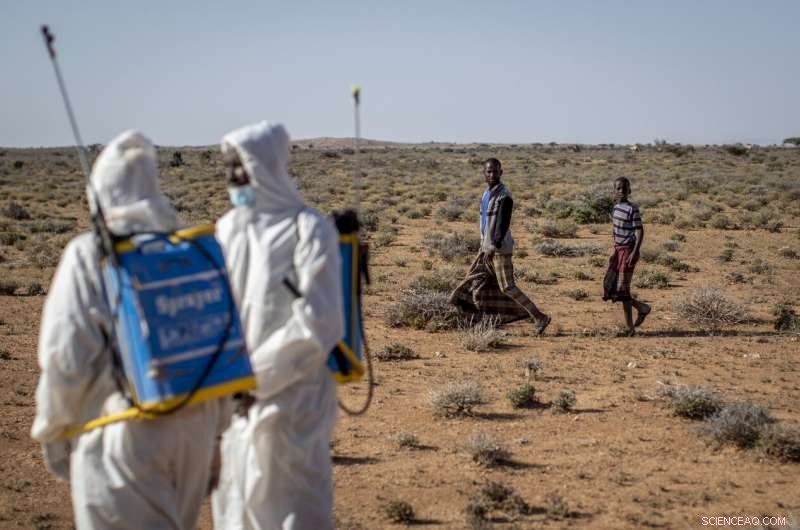
In questa foto scattata martedì, 4 febbraio 2020, Gli irroratori somali per il controllo dei parassiti dimostrano il loro lavoro sui cespugli spinosi nel deserto che è il terreno fertile per le locuste del deserto per una delegazione in visita di funzionari del ministero somalo ed esperti dell'Organizzazione per l'alimentazione e l'agricoltura (FAO), nel deserto vicino a Garowe, nella regione semi-autonoma del Puntland in Somalia. Le locuste del deserto in questa zona arida della Somalia settentrionale sembrano meno minacciose degli sciami di miliardi di membri che infestano l'Africa orientale, ma le giovani locuste saltellanti sono la prossima ondata dell'epidemia che minaccia più di 10 milioni di persone in tutta la regione con una grave crisi della fame. (Foto AP/Ben Curtis)
Ma quel clima più secco non è necessariamente la soluzione, disse Dominique Burgeon, il direttore dell'emergenza e della resilienza della FAO.
La densità delle locuste è ora così alta che anche la normale umidità può portare a un'altra generazione, Egli ha detto.
"Non possiamo credere che Madre Natura lo risolva, " Lui ha spiegato.
Senza abbastanza spruzzi per fermare gli sciami, la già preoccupante epidemia potrebbe trasformarsi in una piaga, "e quando hai la peste, ci vogliono anni per controllare, " Egli ha detto.
Contro quella prospettiva ampia, alcuni lavoratori mascherati con tute protettive bianche e contenitori di pesticidi legati sulla schiena si trovavano nel deserto somalo attraversato da cammelli, spruzzando le migliaia di locuste aggrappate ai cespugli spinosi.
Il cambiamento climatico del mondo comporta il rischio che altri cicloni provengano dal riscaldamento dell'Oceano Indiano al largo dell'Africa orientale, dicono gli esperti di clima. Con quello, la probabilità di ulteriori focolai di locuste cresce.
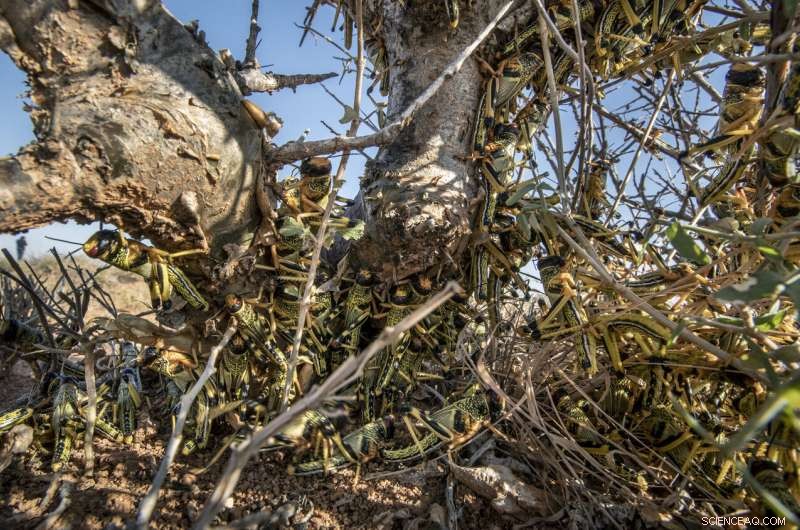
In questa foto scattata martedì, 4 febbraio 2020, giovani locuste del deserto che non hanno ancora messo le ali si affollano su un cespuglio spinoso nel deserto vicino a Garowe, nella regione semi-autonoma del Puntland in Somalia. Le locuste del deserto in questa zona arida della Somalia settentrionale sembrano meno minacciose degli sciami di miliardi di membri che infestano l'Africa orientale, ma le giovani locuste saltellanti sono la prossima ondata dell'epidemia che minaccia più di 10 milioni di persone in tutta la regione con una grave crisi della fame. (Foto AP/Ben Curtis)
La "sorta di nuova normalità, " ha detto Burgo.
E questo significa Kenia, L'Etiopia e altri paesi dell'Africa orientale che raramente vedono tali focolai e si sono trovati in gran parte impreparati a questo, potrebbero unirsi ai "paesi in prima linea" in alcune parti dell'Africa occidentale e del Medio Oriente, dicono gli esperti. Questi paesi dispongono di sistemi di monitoraggio e prevenzione ben addestrati per le epidemie di locuste più frequenti.
The FAO has asked international donors to give $76 million immediately to help control this outbreak. So far $19 million is in hand, Burgeon said.
"The biggest challenge is the scale of the breeding, as you can see all around us, " Barca said. These locusts, Egli ha detto, will be migrating to southern Somalia and parts of Kenya and Ethiopia just as crops are germinating there.
"If at that time there are huge quantities of locusts around, it will have a devastating impact on the crops, " Burgeon said.

In this photo taken Wednesday, Feb. 5, 2020, young desert locusts that have not yet grown wings cover the ground in the desert near Garowe, in the semi-autonomous Puntland region of Somalia. The desert locusts in this arid patch of northern Somalia look less ominous than the billion-member swarms infesting East Africa, but the hopping young locusts are the next wave in the outbreak that threatens more than 10 million people across the region with a severe hunger crisis. (AP Photo/Ben Curtis)
Other East African countries including Uganda, South Sudan, Eritrea and Djibouti are also at risk, Burgeon said. Millions of people in some of these places are already facing hunger in the wake of civil war or more common challenges such as poverty.
Here in rural Somalia, where about 50% of the people depend on animals for their livelihoods, the locusts are eating the pasturage. The animals weaken, their milk decreases and small children, who depend on the milk to survive, suffer skyrocketing malnutrition, the experts said.
Those fighting the locust outbreak may try to negotiate with Somalia's extremist fighters to allow spraying in rural areas where they are active, Burgeon said. Already emergency workers are going in where they can.
In a few weeks the young locusts will shed their skin, said Keith Cressman, a senior locust forecasting officer with the FAO.
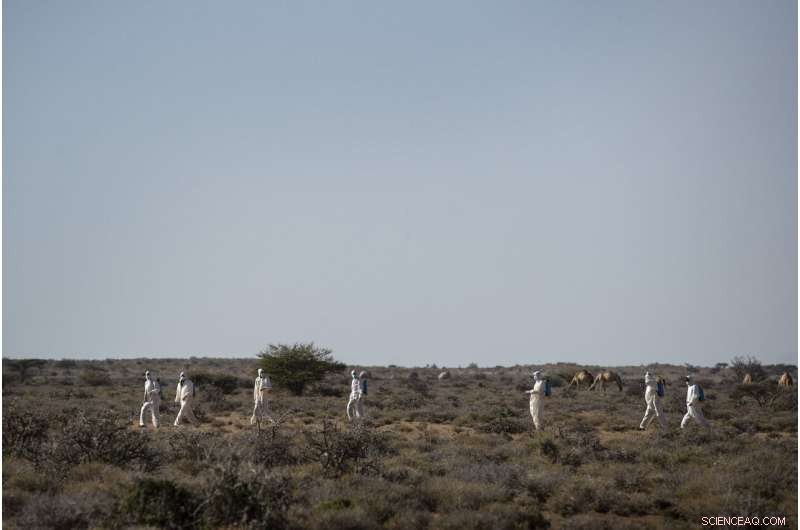
In this photo taken Tuesday, Feb. 4, 2020, Somali pest-control sprayers demonstrate their work on the thorny bushes in the desert that is the breeding ground of desert locusts for a visiting delegation of Somali ministry officials and experts from the Food and Agriculture Organization (FAO), in the desert near Garowe, in the semi-autonomous Puntland region of Somalia. The desert locusts in this arid patch of northern Somalia look less ominous than the billion-member swarms infesting East Africa, but the hopping young locusts are the next wave in the outbreak that threatens more than 10 million people across the region with a severe hunger crisis. (AP Photo/Ben Curtis)
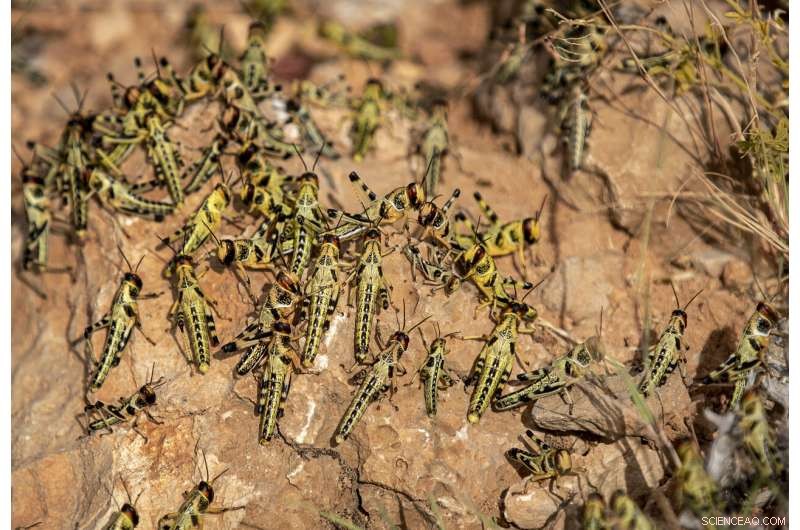
In this photo taken Wednesday, Feb. 5, 2020, young desert locusts that have not yet grown wings crowd together on a rock in the desert near Garowe, in the semi-autonomous Puntland region of Somalia. The desert locusts in this arid patch of northern Somalia look less ominous than the billion-member swarms infesting East Africa, but the hopping young locusts are the next wave in the outbreak that threatens more than 10 million people across the region with a severe hunger crisis. (AP Photo/Ben Curtis)
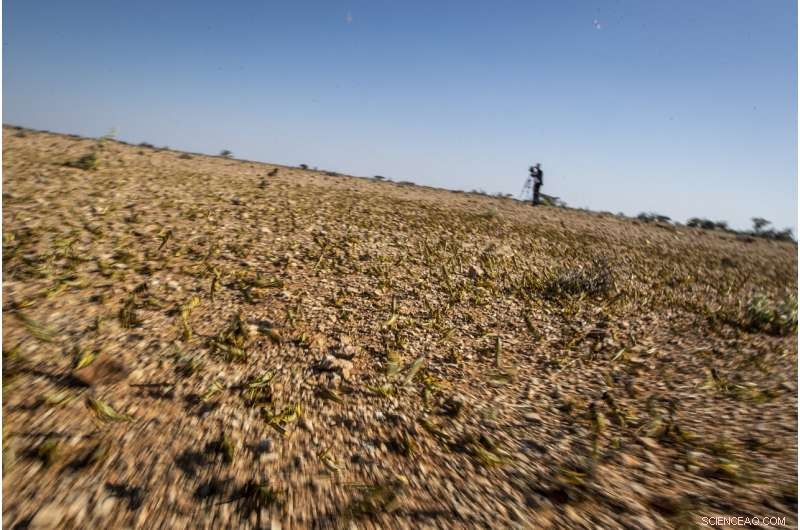
In this photo taken Tuesday, Feb. 4, 2020, young desert locusts that have not yet grown wings jump in the air as they are approached in the desert near Garowe, in the semi-autonomous Puntland region of Somalia. The desert locusts in this arid patch of northern Somalia look less ominous than the billion-member swarms infesting East Africa, but the hopping young locusts are the next wave in the outbreak that threatens more than 10 million people across the region with a severe hunger crisis. (AP Photo/Ben Curtis)
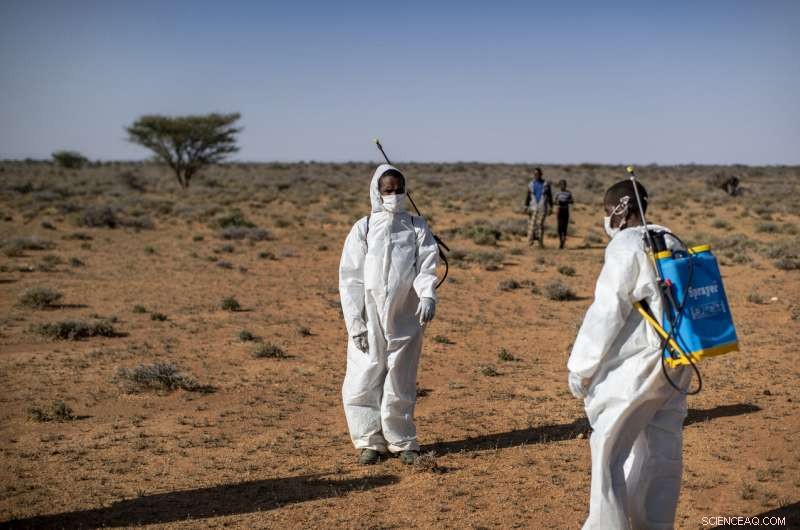
In this photo taken Tuesday, Feb. 4, 2020, Somali pest-control sprayers demonstrate their work on the thorny bushes in the desert that is the breeding ground of desert locusts for a visiting delegation of Somali ministry officials and experts from the Food and Agriculture Organization (FAO), in the desert near Garowe, in the semi-autonomous Puntland region of Somalia. The desert locusts in this arid patch of northern Somalia look less ominous than the billion-member swarms infesting East Africa, but the hopping young locusts are the next wave in the outbreak that threatens more than 10 million people across the region with a severe hunger crisis. (AP Photo/Ben Curtis)

In this photo taken Wednesday, Feb. 5, 2020, young desert locusts that have not yet grown wings jump in the air as they are approached, as a visiting delegation from the Food and Agriculture Organization (FAO) observes them, in the desert near Garowe, in the semi-autonomous Puntland region of Somalia. The desert locusts in this arid patch of northern Somalia look less ominous than the billion-member swarms infesting East Africa, but the hopping young locusts are the next wave in the outbreak that threatens more than 10 million people across the region with a severe hunger crisis. (AP Photo/Ben Curtis)

In this photo taken Tuesday, Feb. 4, 2020, pest-control sprayers demonstrate their work on the thorny bushes in the desert that is the breeding ground of desert locusts for a visiting delegation of Somali ministry officials and experts from the Food and Agriculture Organization (FAO), in the desert near Garowe, in the semi-autonomous Puntland region of Somalia. The desert locusts in this arid patch of northern Somalia look less ominous than the billion-member swarms infesting East Africa, but the hopping young locusts are the next wave in the outbreak that threatens more than 10 million people across the region with a severe hunger crisis. (AP Photo/Ben Curtis)

In this photo taken Tuesday, Feb. 4, 2020, pest-control sprayers demonstrate their work on the thorny bushes in the desert that is the breeding ground of desert locusts for a visiting delegation of Somali ministry officials and experts from the Food and Agriculture Organization (FAO), in the desert near Garowe, in the semi-autonomous Puntland region of Somalia. The desert locusts in this arid patch of northern Somalia look less ominous than the billion-member swarms infesting East Africa, but the hopping young locusts are the next wave in the outbreak that threatens more than 10 million people across the region with a severe hunger crisis. (AP Photo/Ben Curtis)

In this photo taken Wednesday, Feb. 5, 2020, a policeman looks at young desert locusts that have not yet grown wings covering the ground in the desert near Garowe, in the semi-autonomous Puntland region of Somalia. The desert locusts in this arid patch of northern Somalia look less ominous than the billion-member swarms infesting East Africa, but the hopping young locusts are the next wave in the outbreak that threatens more than 10 million people across the region with a severe hunger crisis. (AP Photo/Ben Curtis)

In this photo taken Wednesday, Feb. 5, 2020, an official from the Food and Agriculture Organization (FAO) demonstrates the "eLocust3" software used to record and track the location and movements of locusts using GPS and transmit the data via satellite, in the desert near Garowe, in the semi-autonomous Puntland region of Somalia. The desert locusts in this arid patch of northern Somalia look less ominous than the billion-member swarms infesting East Africa, but the hopping young locusts are the next wave in the outbreak that threatens more than 10 million people across the region with a severe hunger crisis. (AP Photo/Ben Curtis)

In this photo taken Wednesday, Feb. 5, 2020, Dominique Burgeon, centro, Director of the Emergency and Resilience Division of the Food and Agriculture Organization (FAO) and Keith Cressman, Giusto, Senior Locust Forecasting Officer for FAO, walk in the desert between Garowe and Qardho, in the semi-autonomous Puntland region of Somalia. The desert locusts in this arid patch of northern Somalia look less ominous than the billion-member swarms infesting East Africa, but the hopping young locusts are the next wave in the outbreak that threatens more than 10 million people across the region with a severe hunger crisis. (AP Photo/Ben Curtis)
"It takes a few days to warm up their wings, " he said. Some test flights follow and they're on the move.
The locusts at that stage are bright pink and in their most voracious state, like "very hungry teenagers, " Cressman said. By now, many people in Kenya and Ethiopia know them well.
After a month or so, the locusts will be mature adults, ready to reproduce.
Soon after copulating and laying eggs the locusts will die, "but their progeny will be hatching, " Cressman said. "And we have another generation of locusts to contend with, with about another 20-fold increase."
© 2020 The Associated Press. Tutti i diritti riservati.